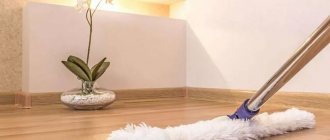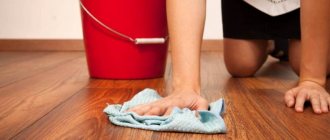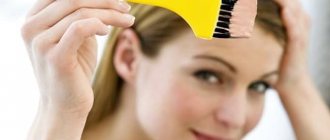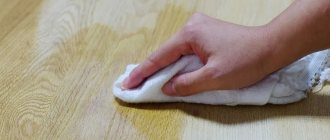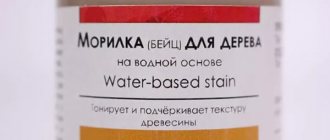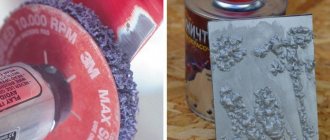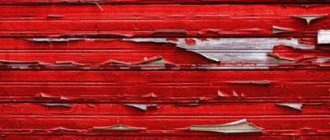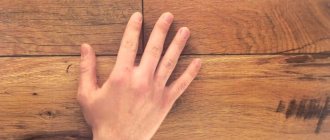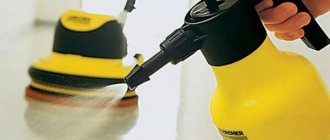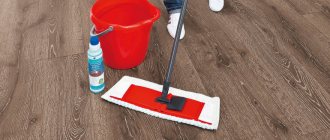Linoleum, like any floor covering, can develop stains over time. What to do with them? Not everyone knows how to remove stains from linoleum. The specificity of the coating is that it is important to combat dirt so as not to damage the thin decorative layer, scratch it or erase it. Plus, this flooring does not like excessive moisture and abrasive materials.
Clean and beautiful linoleum
We remove and remove contaminants
Stains on any linoleum are a problem, especially if you don’t have special products at hand. There are plenty of the latter on store shelves, and you can solve the problem of pollution simply by using such products. But for certain reasons, housewives are in no hurry to buy them, because although they will remove pollution, they can harm the residents of the house with their chemical composition.
There are many folk methods and remedies that can cope with removing stains just as well.
Note! If new contaminants appear on the coating every now and then, you need to understand why this is happening. Without knowing the reason, you can fight against windmills, because pollution will appear again and again.
How to remove paint from linoleum Choosing products that can be used to remove stubborn stains of paint from linoleum
How to wash linoleum from dirt at home How to wash linoleum from dirt - means and methods for cleaning the surface at home
Available products can help deal with various stains. This:
- Soap.
- Gasoline, turpentine.
- Napkins.
- Acetone and nail polish remover.
- Plastic spatula.
- Fine-grained sandpaper, pumice.
- Vegetable oil.
- Hydrochloric acid.
- Camphor alcohol.
- Hydrogen peroxide.
- Acetic acid.
- Potassium permanganate.
Every housewife has most of these products at home, so you don’t have to worry about what and how to remove stains from linoleum. Although it is worth learning about the methods in more detail, because some products can damage the coating irrevocably.
Any stains must be removed immediately
It is worth remembering that you need to monitor the condition of the coating regularly and immediately remove any dirt that appears, this way you will be able to avoid their penetration into the thickness of the canvas, because such defects are sometimes very difficult to deal with.
Removing stains from linoleum
Before you begin removing stains from the flooring, you must prepare personal protective equipment. Even if harmless, non-toxic substances are used for cleaning, it is still recommended to protect your hands from them by wearing high rubber gloves.
A set of tools and special products for caring for floor coverings. Don't forget about the necessary precautions!
When choosing caustic drugs, your eyes also need to be protected by at least using regular glasses.
In addition, you will need a brush, soft napkins or soft rags, toilet paper or paper napkins and a container for warm water.
Due to the fact that the nature of the appearance of stains can be different, the methods for cleaning them also differ. Therefore, they should be considered separately.
Green stains
One of the most corrosive substances that is difficult to remove from linoleum is brilliant green, popularly called brilliant green. It is especially difficult to remove traces of it if a whole bottle of this disinfectant is spilled on the coating, which was not immediately removed, since it is very quickly absorbed into any surface.
One of the fairly common problems that causes a lot of trouble is brilliant green that gets onto the surface of the linoleum.
- Therefore, if such a nuisance occurs, the first thing you need to do is, without any delay, carefully blot the puddle with a soft cloth or paper towel. Any toilet paper will also work for this purpose. The stain should not be rubbed - the puddle should be absorbed into the napkin without increasing in area.
- Another way to prevent the brilliant green from spreading and smearing is to fill it with salt or sand, which will quickly absorb the liquid. After the liquid has been removed from the surface, the stain remaining on the coating must be washed with a chlorine-containing agent added to an aqueous soap solution. If necessary, chlorine powder can be poured directly onto the stain, but not for long, no more than five minutes, as it can not only remove the brilliant green, but also leave white faded marks on the coating.
- Another option for removing fresh stains from brilliant green is 30% acetic acid and hydrogen peroxide. To use them, you need to prepare a piece of cotton wool or a soft cloth, which is soaked in vinegar and peroxide and placed on top of the stain. However, these products are not suitable for cleaning thin linoleum, as they can damage it.
The reaction between regular baking soda and acetic acid helps to deal with green stains
- Vinegar can also be used in combination with baking soda. The stain is poured last, and then a small amount of 9% vinegar is poured onto it. As a result, a reaction occurs in which the mixture perfectly reduces the greens.
- You can try using laundry soap to remove brilliant green. A thick solution should be prepared from it - 2 tablespoons of grated soap per 1 cup of boiling water. This composition must be applied hot to the green stain, then moisten a soft cloth in it and place it on top of the area to be cleaned for several hours. In some cases, this procedure must be repeated several times. Instead of washing powder, a dry cleaning agent can be used.
Filling a fresh stain of brilliant green with washing powder.
- Sometimes washing powder for white fabrics is suitable for getting rid of green stains. You can immediately cover spilled brilliant green with it - just like salt or sand, it can absorb liquid, but at the same time it will lighten the brilliant green itself, which has already been absorbed into the coating. Instead of washing powder, you can use a dry cleaning agent used for dishes, which is usually found in every kitchen.
It is more difficult if the “traces of the crime” are noticed late, and the brilliant green has already managed to be absorbed into the coating.
However, there are ways for such cases. To remove old diamond green stains, there are a number of other substances and recipes:
- Acetone, gasoline or kerosene will help deal with brilliant green that was spilled a long time ago and has managed to penetrate the structure of the top layer of the floor covering. One of the selected products is applied to a cotton swab, which is used to treat the stain. This swab should be left on the surface for 40–60 minutes. True, the process should be periodically monitored so as not to completely ruin the linoleum.
Treatment in two stages can help deal with old stains of brilliant green: first vinegar + potassium permanganate, then vinegar + hydrogen peroxide.
- A two-step process that uses acetic acid, potassium permanganate (potassium permanganate) and hydrogen peroxide will help you deal with old brilliant green stains. The first stage consists of applying a solution consisting of 50 grams of 9% vinegar and potassium permanganate, taken on the tip of a knife. When the crystals dissolve in the mixture, you need to wet the sponge and then treat the green spot with it, which should change color to a brownish-yellow hue. After this, the stain is washed with warm water. Next comes the second stage, during which hydrogen peroxide should be applied to the stain, to which 30% vinegar is added. This composition should lighten and clean the stain. If necessary, the cleaning steps must be repeated.
- Camphor alcohol is also often used when you want to get rid of brilliant green on linoleum. The product must be rubbed well into the stain and then rinsed with warm water.
- Hydrochloric acid in a concentration of 3÷5% is the most effective cleaning agent for brilliant green. It is applied to the stain for a few minutes, after which the floors are wiped with a damp cloth. But at the same time, there remains a possibility of damaging the linoleum if the material does not have the proper resistance. Therefore, first it is better to conduct an experiment to see how the coating will behave when exposed to acid, on a small, inconspicuous area of the floor.
Rust on linoleum
Another difficult-to-remove contaminant from linoleum is rust, which also eats well into the structure of the material and is clearly visible on light-colored coatings. These may be red or brown spots in the shape of metal objects that have stood or previously been lying in this place for quite a long time.
Steel objects standing motionless in one place for a long time can leave stubborn rust stains on the linoleum.
Such stains can be removed using special products. Another option is to try to cope with them using folk remedies:
- Lemon juice. In order to get rid of rust using this product, moisten a soft cloth with lemon juice and apply it to the stain, leaving it to dry. If necessary, the procedure must be repeated. If the dirt is small in size, then you can even place a cut slice of lemon on top of it.
- In addition to regular juice, citric acid is used to remove stains, which can be purchased in liquid or crystallized form. To prepare the composition, you will need a glass of hot water, to which is added a teaspoon of salt and the same amount of acid. The resulting solution treats rust on linoleum. If necessary, several times.
- Another way to clean old rust stains from linoleum is with chlorine bleaches, such as White. It is diluted with water in a ratio of 1:10, and then the resulting composition is applied to the stain and left for 40-60 minutes. After this, the linoleum is washed and treated with lemon juice.
- Kerosene is also widely used to combat rust stains. You can pour it onto the area to be cleaned or moisten a soft cloth with it generously and lay it on the rust for 35-40 minutes. After the specified time, the linoleum is washed with warm water.
- Acetic acid (one tablespoon), diluted in a glass of water, and ammonia solution. The first step is to treat the stain with a vinegar solution, and then immediately apply ammonia to it. This procedure should be repeated several times until the desired result is achieved.
Ink stains
Ink stains have recently become quite rare on linoleum, as fountain pens and sippy-drip inkwells have become a thing of the past. However, if for some reason an ordinary ballpoint pen sits under a hot radiator or on an area of the floor heated by the sun's rays, then the linoleum will be stained with ink.
So, how to remove these unpleasant stains from the surface, which significantly spoil the appearance of the coating.
- If an ink stain is detected immediately, before the liquid has had time to evaporate, then the first thing to do is to blot the stain with a paper towel or toilet paper. Thick ballpoint pen paste should be carefully collected with a spatula, being careful not to smear the stain over the surface.
- The next step is to apply detergents. Domestos is good for removing ink. It can be used in its pure form, poured onto pre-moistened stains and left to act on it for 5-10 minutes. Instead of the above-mentioned product, the usual “Whiteness” or another chlorine-containing substance is used.
- If a “picture” was found on light linoleum, drawn by a child with a ballpoint or gel pen, then to clean the surface you can use dry dishwashing powder, and then the same “Domestos”
- Turpentine and gasoline are good helpers in the fight against ink. These compounds are applied to a napkin, which is used to wipe off the dirt. You can leave the fabric on the stain for 10-15 minutes. These products will not damage the surface of the coating.
Stains from rubber soles of shoes
Traces of black rubber left on linoleum by the soles of shoes are also difficult to remove. However, there is a solution here too. To clean such stains, gasoline is used to wipe off the dirt.
Traces from rubber soles, shoe polish or tar accidentally brought onto shoes from the street should “move away” when treated with pure gasoline.
This product is also suitable for removing shoe polish or tar, which can also be brought home on shoes.
Wax stains
Cleaning wax from linoleum is easy. If it somehow gets on the coating, do not touch it until it cools down. Then, the wax can be easily removed with a knife or spatula.
You can remove a wax stain from linoleum using the “hot method” - using an iron and a napkin.
- If the wax is spread over the coating in a thin layer, then the area contaminated with it should be covered with a paper towel, toilet paper, laid in several layers, or a thick, well-absorbent cloth. Then, it is recommended to lay parchment paper on top of it (so as not to stain the sole of the iron with wax). After this, the paper is ironed with a well-heated iron. The wax should melt and be absorbed into a soft cloth. In the same way, wax can be removed from carpet or other coverings.
- If there is a stain left on the coating from colored wax, it can be removed with gasoline.
You should not try to peel off a thin layer of wax with a spatula or knife. The sharp edges of the tool can easily damage the coating, especially if it is made of foamed PVC.
Oily stains
Grease stains on linoleum mainly occur in the kitchen. Usually, in such conditions, there is always a means at hand that can quickly prevent the spreading and solidification of oil or fat.
- If a greasy substance has just been spilled on the floors, then you should urgently cover it with any powder - it could be salt, soda, washing powder or dishwashing detergent. Instead of bulk products, you can use paper towels, laying them on top of the fat in several layers. After waiting for the oil to be absorbed, the powder or wipes must be removed by throwing it in the toilet or trash can. The area to be cleaned is thoroughly washed with any soap solution. If the grease is not removed in time, it can spread throughout the apartment and ruin not only the linoleum, but also firmly settle in the carpeting.
- If the greasy stains on the linoleum are old and mixed with dust and dirt (this can happen in hard-to-reach, inconspicuous places), then cleaning them will take more time. First, they should be soaked by placing a rag soaked in a soapy solution on top. Under the influence of the detergent, the stain should soften, and it can be easily cleaned with the hard side of a sponge or a stiff brush. After removing the grease, the coating naturally needs to be washed by adding detergent to warm water.
Mold on linoleum
If black mold has captured most of the linoleum, then you shouldn’t even waste effort, time and health on removing it, since the coating will simply have to be bathed in bleach. And at the same time, there is still no guarantee that the damage will be dealt with, since the lesions could well have managed to penetrate into the structure of the coating, and after a while the mold will appear again. Such linoleum must be dismantled and removed away from residential premises - simply sent to a landfill.
Such linoleum cannot be restored. It will have to be dismantled and replaced with another covering after carrying out certain “therapeutic” procedures on the base of the floor.
After removing the damaged coating, the fight against mold does not end. To ensure that the new linoleum does not soon suffer from microflora, pockets of which are probably preserved at the base, and possibly along the lower part of the walls, it is necessary to take a number of measures. And first of all, you should determine the cause of mold.
- In panel houses, this could be poorly sealed seams between wall slabs, through which external moisture, penetrating from the street, moistened the linoleum, thereby creating a favorable environment for the formation and development of mold. Therefore, the seams will have to be cleaned and filled with a new, more moisture-resistant solution. Usually this work is entrusted to professional builders.
- Floors located above an unheated and unventilated basement are particularly susceptible to mold damage. Here you will have to work on the ceiling both from the basement and from the apartment side, and also try to arrange the possibility of air ventilation in the lower room. Floor slabs must be treated with deep penetration antiseptic primer in several layers. Some solutions are capable of penetrating 150 mm into the structure of the slab, which will provide high-quality protection for the floor material.
- Before covering the floors with a new coating, it is recommended to insulate the floors of the first floor. For this purpose, it is better to choose a non-moisture-absorbing, “breathable” material.
Insulating the floors of the first floor is an important task!
High-quality thermal insulation will not only improve indoor comfort, but will also significantly reduce the likelihood of mold damage to the ceiling and floor covering. Detailed information about methods and materials for insulating the floor of the first floor is available in a special publication on our portal.
If mold was found on the linoleum in one of the corners of the room, then you can try to fight it. And this process consists of the following stages:
- The linoleum must be freed from the baseboard and unscrewed, revealing the base. Then, also find and eliminate the cause of the fungus. External moisture should not penetrate into the room, otherwise all work to combat mold will be in vain.
- Next, the area on the base of the floor, as well as on the linoleum, where mold stains are found, must be washed well with a chlorine solution and then dried well. For these purposes, you can use a heat gun or a heat fan, which is directed at the treated area.
It is completely pointless to remove mold stains on linoleum if the causes of its appearance and high-quality “treatment” of the affected area of the floor and walls have not been carried out.
- Then, the affected areas should be treated with special antiseptic compounds that can penetrate deeply into the structure of the materials. After treatment, the surfaces and flooring must be thoroughly dried.
- After this, the linoleum can be returned to its place. It should be remembered that this area of the floor must be constantly monitored. Because if you miss the moment, mold can “reanimate” and even take over the walls of the room.
Paint stains on linoleum
To easily remove recently spilled oil or alkyd paint from linoleum, you can use regular sunflower oil. It copes well with compounds that have not yet hardened. In addition, the oil can also be used to wash hands from paint that is not of aqueous origin.
- In addition, a fresh paint stain can be removed using a soap-soda solution, which requires 1 liter of warm water, 20 grams of laundry soap and the same amount of baking soda. The area of contamination is washed with this composition; if necessary, the surface will have to be rubbed with the hard side of the sponge. After which the floors are washed with warm water.
- It is more difficult to remove dried “blots” or traces of paint scattered across the surface. But this is also quite possible. To work, you will need solvent “646”, which is used to moisten a napkin and generously moisten the contaminated area with it. The solvent is able to penetrate between paint and linoleum. After this, the stain is usually easily removed from the surface; you just need to carefully lift it with the edge of a knife or spatula.
Cat urine odor and stains
Cat urine has a persistent odor that persists for a long time, especially in cases where the stains are not removed immediately.
If the puddle is immediately removed and washed, then there will be no traces or smell left of it.
To get rid of this trouble, you can use several means - hydrogen peroxide, iodine diluted in water, vodka, lemon juice, vinegar or chlorine-containing compounds.
- Vodka is a good stain and odor remover. In addition, cats categorically cannot stand the “aroma” of alcohol, but it itself does not linger for long in an open place. Therefore, this product can be used for fresh stains - that is, after removing the liquid with a regular rag, you should immediately treat the area with vodka or alcohol.
- Vinegar is more resistant to weathering. The 9% composition is diluted in a 1:1 ratio with water, and sprayed from a spray bottle into the contaminated area and left for a couple of hours. Then, the linoleum must be washed with water, adding a detergent that has a pleasant aroma.
- Natural lemon juice can be used either pure or diluted 1:1 with water. The juice is applied to the stain and also left for one to two hours, then washed off and wiped dry.
- Iodine will also help remove unpleasant odors and stains. A solution is prepared from it - 20÷25 drops of this antiseptic substance are added to one liter of water. This composition is used for application to a dirty area.
- In addition to home remedies, OdorMedic, Urine-Off and UrineOut solutions specially designed for this purpose, sold in pet stores, are used to remove stains and odors. However, their cost is quite high, and the effectiveness of “folk remedies” seems to be no worse.
Other types of stains
In addition to the stains listed above, other contaminants may appear on the linoleum. They will be briefly discussed in this section of the article:
Old iodine stains are difficult to remove. But it's still worth a try.
- If iodine stains are found on the linoleum, chlorine-containing products are used to remove it. They are applied thickly directly to the stain, without removing the substance beyond the contamination. These compounds must be used very carefully, controlling the process so that no whitish area remains on the coating. In addition to these products, you can use soda or starch by applying the powder to a damp cloth and placing it on the stain. An alternative to starch is potatoes cut in half.
- To clean food coloring, coffee stains, and drawings made with a felt-tip pen or marker, use turpentine, gasoline, alcohol or kerosene.
It is best to remove marks from felt-tip pens and markers with alcohol.
- Sticky gum can be separated from the coating by first cooling the gum, placing dry or regular ice on top of it, placing it in a bowl and placing it on top of the stain. After cooling, the gum can be easily removed from the surface with the tip of a knife or spatula. But this procedure must be performed very carefully so as not to damage the coating.
- Putty or whitewash smeared on the floor can be washed off with warm water, adding a little vinegar to it. The solution should be slightly acidic. It will help remove not only stains, but also stains from building mixtures. In this case, the coating will have to be washed several times and then wiped dry with a clean cloth.
- If the putty has become ingrained into the linoleum structure, it can be removed with white spirit.
- Traces of tape or plaster, on which dirt and dust have managed to stick, can be easily removed with vegetable oil or vodka.
As you can see from the information presented, basically, products with similar compositions, but prepared in different proportions, are used to remove stains.
Some features of pollution control
Before considering the methods and techniques of using a variety of means, you should learn some rules:
- Before removing the stain, the area of the coating must be treated with a soap solution. It is likely that this will help remove it immediately. If not, then you can resort to other methods.
- To prevent whitish or yellowish stains from appearing on light linoleum, you should not wash it with high-temperature water - it does not like this. Yellow spots on linoleum can also appear from ammonia and soda in their pure form.
- Before using any composition, you need to test it on a small piece of coating, preferably in an inconspicuous place. In this case, you need to use a white rag, so you can immediately notice whether the coating pattern is transferring to it. If there is no undesirable reaction, then you can safely use the composition on the contamination.
Turpentine helps with various stains on linoleum
First way
The floor covering is cleared of yellowness using sunlight. The linoleum is carefully dismantled and hung outside so that the material receives direct sunlight. Decide for yourself exactly how long you need to keep it outside. In general, the duration of the procedure depends on the degree of yellowness. If you are satisfied with the result, return the linoleum to its original place.
This method is good and does not require financial costs, but not everyone has the opportunity to dismantle the floor covering just to remove the yellowness. For many, this will require removing furniture from the room. You don’t have to dismantle the linoleum and take it outside, but simply remove the carpets. They can be taken out of the room or rolled up. This opens up light to the linoleum.
Per liter of water 1 tbsp. spoon of peroxide: 5 tips for growing pepper seedlings
Not a warehouse, but a place to relax: how to decorate a balcony on a minimal budget
Rare 20,000-year-old Paleolithic blade found in China
Types of pollution
Another important fact for successfully removing stains from linoleum is determining their type and origin, this will make it easier to choose a product. The options are varied, but the most common are:
- Oily spots.
- Traces of food: mayonnaise, ketchup, mustard.
- Traces of rust, iodine, mold, brilliant green.
- Marker drawing, ink drops.
- Contaminants of unknown origin. Most often these are pinkish or red spots. If they appear on linoleum, then the fight against them will be long and persistent.
Getting rid of paint
The easiest way is to remove fresh paint. Blot liquid drops of enamel with a rag, wipe the stained area with a damp sponge and treat with a dry cloth.
- Fresh oil paint, even if it is cleaned in time with a rag, leaves cloudy stains on the floor.
- Pour sunflower oil over them and wait a couple of minutes. Collect the remaining oil with a napkin, and wash the greasy stain with household items. soap.
- If traces of paint are still visible, you will have to use White Spirit. It will quickly remove paint stains.
- Use it carefully and wash the surface thoroughly immediately after use. Linoleum does not like the effects of solvents, gasoline, kerosene and other aggressive substances.
The hardened paint must first be carefully scraped off and then removed with the same solvent.
Simple spots
To avoid the need to use strong cleaning agents, it is necessary to carry out regular maintenance of the coating.
Regular care
Dirt and dust can be removed as follows:
- Make a soap solution. To do this, dissolve grated laundry soap (100 g) in 10 liters of warm water.
- Soak a rag in this mixture and rub the stain.
- Rinse with warm water and dry the area with a well-absorbing cloth.
Yellowness
Yellow stains, as well as traces of wax, paraffin and other melting substances, if any, can be removed with an iron. To do this you need:
- Apply several layers of rags or paper to the contaminated area, not newspaper, as it may imprint on the coating.
- Heat the iron.
- Place the device on cloth or paper. Contamination should transfer to the absorbent material.
- Then the area of contamination should be washed with soapy water.
Potassium permanganate - time-tested and generations-tested
Tough Spots
They can be different, these are the already mentioned red spots of unknown origin, marker and marks from tires (for example, stroller tires), shoe soles, and other rubber. There are several options.
“Rubber” marks and shoe polish are removed with gasoline. To do this, you need to soak a rag in it, rub the dirt, then rinse the floor with water and wipe dry.
The same method will help if stains from fresh asphalt appear on the surface. In some cases, you will have to use both gasoline and acetone.
Ink, corrector, and marker can be removed with vegetable oil; it is recommended to use linseed oil. The technique is simple:
- Rub the concealer or marker stain with an oil-soaked rag.
- Polish.
In this case, there is no need to wash off the oil.
Before removing rust, you need to squeeze out the juice from the lemon, because it is the one that best fights such contaminants. Other household stains, such as marks from fruits and vegetables, can be easily removed with hydrochloric acid.
Why does linoleum turn yellow and how to get rid of it?
comment to favorites Krove lyshchitsa [10K] 7 years ago
Linoleum can turn yellow from external influences. These can be shoe polish, various dirt (bitumen, for example) that we bring on our shoes from the street, accidentally spilled hair dye, etc. To prevent this from happening or to happen as late as possible, you need to properly care for the linoleum: clean it from dirt, dust, sand. When washing with water, change the water several times; to add shine, you can use a polishing emulsion. But aggressive agents (gasoline, for example) cannot be used for cleaning.
moderator selected this answer as the best comment add to favorites link thank Kim Jong-un [412K] 4 years ago
Usually old linoleum that is laid in places with high traffic (a corridor, for example) turns yellow.
If new linoleum turns yellow, then it is a low-quality material, or defective.
And it turns yellow because in the production process of linoleum, special substances (plasticizers) are used, which give the material that same elasticity.
Plasticizers are found in the top layer of the material; people wear shoes on the linoleum; there may be dust, dirt, or other contaminants on the surface of the linoleum; all this reacts with those same plasticizers and as a result we get that same yellowness on the surface.
It is useless to fight, the yellowness is not on the surface, it is much deeper, it’s time to change the coating, or somehow decorate the problem area (for example, lay down a rug).
Yellowness is not fought after the fact; only measures taken in advance work here.
Zelenka
How to clean linoleum from green paint, and whether it is possible to do this, will ask any housewife who has encountered such traces. Indeed, this contamination is one of the most difficult; you can remember how difficult it is to remove brilliant green from your hands. Some rules:
- You cannot smear it, otherwise the affected area will increase. Needs to be blotted.
- It is better to carry out all work wearing rubber gloves.
- The rag must be constantly changed, as the substance quickly eats into it.
There are several ways:
- Peroxide or camphor alcohol - they dissolve the alcohol that is in the composition.
- Baking soda and vinegar. The first step is to pour baking soda onto the dirt and pour vinegar on top. The brilliant green should come off with foam.
- You need to add a little potassium permanganate to the vinegar. Wipe the stain with the resulting mixture.
- Mix peroxide and 30% vinegar and treat the stain.
Fighting green stains on linoleum is a challenge for any housewife
Daily care
The coating does not require scrupulous maintenance. But so that stains on the linoleum do not occur often, and the apartment is fresh and cozy, it is advisable to do wet cleaning daily.
- During the day, dust and various debris accumulate on the floor.
- Sweep up the dirt with a broom, fill a bucket of water, wet the linoleum with a soft cloth and wipe it dry.
- If there are smudges and dirt on the floor, dissolve household items in water. soap and wash the coating again.
How to remove stains on linoleum from water and other light contaminants? “Mr. Proper” has proven himself excellent in this. Dissolve a cap of the product in hot water and stir. A lush foam will appear. The apartment will immediately be enveloped in a pleasant aroma, and after treating the floor, a feeling of freshness will appear. The main advantage of this product is that it does not need to be washed off. When the coating dries, it will become perfectly clean without stickiness or streaks.
Conclusion
You can remove any stains on linoleum, the main thing is not to forget that you need to act with any product carefully, and the first thing you should do is try it out. After applying the composition, it must be washed off and the linoleum wiped dry.
average rating 0
more than 0 ratings
Share link
Comments
Victor 12/29/2017 08:06
We've had linoleum for several years now. Recently, brown spots of varying sizes began to appear in the kitchen. I used various detergents and it didn't help. It was partially possible to remove them with the help of fine sandpaper. A few days later, the stains appeared in another place (only in the kitchen). I had to rub them again (for quite a long time) How to deal with them?
Dmitry Mokeev 05.20.2020 14:33
I can't remove the yellow stains on the linoleum left by bicycle wheels.
How to care for linoleum?
There are certain rules for cleaning different types of linoleum
Linoleum can be natural or made from artificial fibers (PVC). Material made from natural components is considered stronger, but care and precautions are the same for both types of coating. There are several preventive measures that, if followed, can avoid premature deterioration of the material:
- Avoid prolonged contact of linoleum with direct sunlight. Because of this, the coating loses its brightness.
- The material deteriorates from high temperatures, so it is better to clean it with water at 30-35 degrees.
- Artificial linoleum does not like excess moisture. After washing the floors, remove excess water with a dry cloth.
- If bleaches containing chlorine are used for cleaning, they are diluted with water 50:50. Concentrated products cause color loss and possible staining.
- To prevent mechanical damage, special stickers are applied to the legs of heavy furniture.
- It is not recommended to lay linoleum on uninsulated loggias. This leads to the fact that the material begins to deteriorate, deform, and cracks and damage appear.
- Do not use abrasive cloths or powders with large, hard granules for cleaning. After their use, the surface deteriorates and gets scratched.
- If dyes come into contact with linoleum, they must be removed from the surface immediately. Once absorbed, cleaning is extremely difficult.
- It is not recommended to use cleaning products that contain kerosene, acetone and other aggressive substances.
- Before entering the room, lay a rug to clean the soles from dirt that scratches the linoleum.
To extend the service life of the material, it is treated with a special polish or mastic. After applying the compositions, a thin film is formed that protects the linoleum from external damage, ultraviolet irradiation and premature abrasion. The processing principle is as follows
- Saturate a soft sponge with the product and carefully treat the surface of the linoleum.
- Wait until the first layer dries, then apply the second one using the same principle. Rub the product until completely dry, remove any remaining product with a dry cloth.
- After treatment, the floor covering must not be subjected to stress. In order for the film to dry completely, it must be kept for at least 8-10 hours. Only after this time has passed can you walk on the surface. If you do not follow this rule, the protective film will be broken and the desired effect will not be achieved.
Baking Soda Treatment
Another method that may offer faster results is a simple baking soda treatment. It may take more than one treatment to correct discoloration, but results should be faster than with the solar method. Simply clean the floor by removing all types of debris and objects covering the floor. Dampen the yellowed areas with clean water, followed by a light layer of baking soda. Let the mixture sit for 10 to 15 minutes, then wipe the mixture away with a cloth. Repeat the treatment as many times as necessary to achieve the original color of the floor. Continue the treatment in the future during your weekly room cleaning to prevent the stains from appearing again.
How to deal with stains that cannot be removed
Over time, you may notice pink spots on the linoleum. What kind of pollution is this and why do they appear?
Most often these are residual marks from difficult to remove stains or the result of increased use of the coating. There is no way to remove such stains on linoleum. You can help the coating using a radical method. To use it, the remains of the required linoleum must be stored at home.
Using a sharp knife, cut out the reddened area from the coating. A ruler will help make it smoother. Take out a piece of similar linoleum and make a patch that fits the size. Sand the edges of the patch with sandpaper. It will remove all roughness. Apply special glue to the inside of the cut material and fill the empty space. To prevent the seams from bending, coat them with an adhesive called “Cold Welding”.
Removing traces from furniture
Furniture, strictly speaking, leaves not stains on the linoleum, but dents and dented areas. In such cases, there is nothing left but replacing the damaged strip. If, by mistake, rubber or other staining pads are used for the legs, you need to act as you usually deal with stains of the corresponding type.
